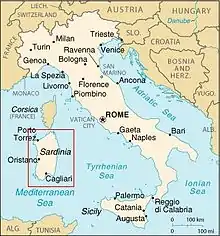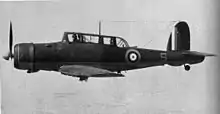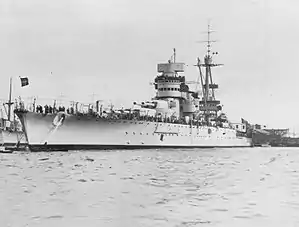| Operation White | |||||||
|---|---|---|---|---|---|---|---|
| Part of the Battle of the Mediterranean of the Second World War | |||||||
 Skua dive bomber forced to crash-land on Sicily | |||||||
| |||||||
| Belligerents | |||||||
|
|
| ||||||
| Commanders and leaders | |||||||
| James Somerville | Inigo Campioni | ||||||
| Strength | |||||||
|
| ||||||
| Casualties and losses | |||||||
| None | ||||||
Operation White (17 November 1940) was a British attempt to deliver fourteen aircraft, twelve Hawker Hurricane fighters and two Blackburn Skua dive bombers, to Malta from the old aircraft carrier HMS Argus. White was one of what became known as Club Runs that supplied fighters for the defence of Malta.
The operation was thwarted by the presence of the Italian fleet, which prompted the premature dispatch of the fighters; combined with bad weather and some poor navigation, this led to only five aircraft reaching Malta, all but one the other pilots and aircraft being lost at sea.[1]
Background
Malta
After the entry of Italy in the Second World War on 10 June 1940, the division of responsibility in the Mediterranean between the French Navy (Marine Nationale) in the west and the British in the eastern Mediterranean ended. To compensate for the withdrawal of the French, the Admiralty established Force H at Gibraltar. The British authorities designed a formal system of aircraft reinforcement to Malta, to assemble an adequate air defence and replace potential losses. Only two routes remained open after the Battle of France, via North Africa, by shuttling the fighters over the Sahara or via the Suez Canal to Egypt and by delivering them by aircraft carrier from the western Mediterranean.[2]
Operation Hurry

Force H (Admiral Sir James Somerville), comprised the fleet carrier HMS Ark Royal, the battleships HMS Valiant and Resolution, the cruisers HMS Arethusa, Delhi and Enterprise and the destroyers HMS Faulknor, Forester, Foresight, Foxhound, Fearless, Escapade, Active and Wrestler. On 2 August, nine Fairey Swordfish aircraft took off from Ark Royal to bomb Cagliari and three to lay mines.[3] 418 Flight of the Royal Air Force (RAF), comprising RAF pilots transferred from their squadrons and other pilots who had been attached to the Fleet Air Arm and trained for deck operations, was the first party to conduct a Club Run.[4][5] On 2 August 1940, the aircraft took off from Argus south-west of Sardinia, sailing independently of Force H, with a destroyer escort comprising HMS Encounter, Gallant, Greyhound and Hotspur.[3]

When the Italian naval headquarters (Supermarina) discovered the sailing of Force H, two lines of submarines, Scirè, Argo, Neghelli, Turchese Medusa, Axum, Diaspro and Luchio Manara were assembled on 1 August to the north of Cap Bougaroûn but the move proved abortive, with no sightings by 9 August.[3] Three Regia Aeronautica (Italian Royal Air force) Savoia-Marchetti SM.79 medium bombers attacked Force H but Skuas from Ark Royal shot down one of the SM.79s and drove off the other two. The British fighters reached the airstrip at Luqa at Malta but two of the aeroplanes crash-landed.[6] The first engagement of the new aircraft took place on the night of 13/14 August, when they shot down another SM.79. By 16 August, 418 Flight and the original Malta units were amalgamated into 261 Squadron.[7]
Prelude
Force H
Following the success of Hurry, another mission was planned for November. The aircraft were to be delivered by Argus again, escorted by Force H from Gibraltar, with the battlecruiser HMS Renown, the carrier Ark Royal, the cruisers HMS Despatch and Sheffield and the destroyers Faulknor, Fortune, Fury, Wishart, Forester, Firedrake, Duncan and Foxhound.[8] The convoy departed Gibraltar at dawn on 15 November. Earlier that day, a report was passed to Somerville that the Italian fleet was at sea south of Naples, to confront Force H. He decided to launch the fighters as soon as possible.[9][10]
Regia Marina
Supermarina, the Italian naval headquarters, was informed of the operation by its spies in Gibraltar four hours after Force H had sailed.[11] Ships of the Regia Marina sailed from Naples and Messina commanded by Admiral Inigo Campioni. By the morning of 17 November, the battleships Vittorio Veneto and Giulio Cesare which had survived the Battle of Taranto (11/12 November 1940) the British air attack on Taranto Harbour.[12] With two heavy cruisers and several destroyers the battleships lay in wait 35 mi (30 nmi; 56 km) south-west of Sardinia.[13]
Operation
First wave

The British convoy was 400 mi (350 nmi; 640 km) west of Malta when the first wave of fighters took off from Argus at 06:15. Given the correct cruising speed, the Hurricanes would have had 45 minutes of fuel in hand after reaching the Malta coast but they lost a third of the reserve while scrambling and forming up. The fighters flew at 150 mph (240 km/h) at a height of 2,000 ft (610 m), far from the optimum height and speed for the distance to be covered. The 510 mi (440 nmi; 820 km)-range of the Hurricane Mk II was achieved at 10,000 ft (3,000 m), not the 2,000 ft (610 m) that the Hurricanes flew, where the air was denser. The formation unexpectedly encountered a headwind, for which no allowance had been made.[14]
The wind backed from south-west to south-east, hampering the eastward flight of the aircraft. Near the Galite Islands, 50 mi (80 km) north of Tunisia and 93 mi (150 km) south of Sardinia, the wave rendezvoused with a Short Sunderland flying boat which lead the formation to Malta. A Hurricane ran out of fuel at 09:08 45 nmi (52 mi; 83 km) from Malta and another 09:12. One of the pilots was rescued by the Sunderland but the other was lost at sea. The four remaining Hurricanes and the Skua landed at Luqa at 09:20.[10]
Second wave

The second wave and its Skua took off an hour later, as the convoy turned back at full speed. The Skua navigator erred in his calculations as the weather got worse and the headwind increased in speed. The wave missed the rendezvous with a Martin Maryland from Malta and one by one, the Hurricanes came down in the sea, their fuel exhausted. All of the pilots were lost at sea and the Skua, 75 nmi (86 mi; 139 km) off course, was shot down by the Italian Army (Regio Esercito) and crashed on the Sicilian coast near Syracuse, Sicily, the crew being taken prisoner.[14]
Aftermath

Somerville privately assessed the operation "a frightful failure" and blamed himself for the tragedy.[14] The official inquiry put the blame on the unfamiliarity of the Hurricane pilots with the Hurricane Mk II, which had a constant-speed propeller. It was agreed that poor weather, the use of a navigator in the Skua who was a volunteer reserve officer, on his first operational sortie, which Somerville called "a positive scandal" contributed to the loss of the Hurricanes.[14] Lack of cooperation between the Navy and the RAF and the reluctance to risk Force H were also blamed for the fiasco. The loss of experienced fighter pilots was particularly painful. The most successful aces survived the ordeal, some of them being veterans of the Battle of Britain.[15]
See also
Footnotes
- ↑ Sturtivant 1982, pp. 37, 82.
- ↑ Shores, Cull & Malizia 1999, pp. 43–44.
- 1 2 3 Rohwer & Hümmelchen 2005, p. 34.
- ↑ Sturtivant 1990, p. 46.
- ↑ Shores, Cull & Malizia 1999, pp. 44–45.
- ↑ Shores, Cull & Malizia 1999, pp. 46–47.
- ↑ Shores, Cull & Malizia 1999, pp. 52–53.
- ↑ Rohwer & Hümmelchen 2005, p. 49.
- ↑ Woodman 2003, p. 92.
- 1 2 Shores, Cull & Malizia 1999, pp. 86–88.
- ↑ O'Hara 2009, p. 65.
- ↑ Greene & Massignani 2002, p. 115.
- ↑ de la Sierra 1976, p. 148.
- 1 2 3 4 Woodman 2003, p. 93.
- ↑ Shores, Cull & Malizia 1999, p. 88.
References
- de la Sierra, Luis (1976). La guerra naval en el Mediterráneo 1940–1943 [The Naval War in the Mediterranean 1940–1943] (in Spanish). Barcelona: Juventud. ISBN 84-261-0264-6.
- Greene, Jack; Massignani, Alessandro (2002) [1998]. The Naval War in the Mediterranean, 1940–1943. Rochester: Chatham. ISBN 978-1-86176-057-9.
- O'Hara, Vincent P. (2009). Struggle for the Middle Sea: The Great Navies at War in the Mediterranean Theater, 1940–1945. London: Conway. ISBN 978-1-84486-102-6.
- Rohwer, Jürgen; Hümmelchen, Gerhard (2005) [1972]. Chronology of the War at Sea, 1939–1945: The Naval History of World War Two (3rd rev. ed.). London: Chatham Publishing. ISBN 1-86176-257-7.
- Shores, Christopher; Cull, Brian; Malizia, Nicola (1999). Malta: The Hurricane years (1940–41). London: Grub Street. ISBN 0-948817-06-2.
- Sturtivant, Ray (1982). Fleet Air Arm at War. London: Ian Allan. ISBN 978-0-7110-1084-0.
- Sturtivant, R. (1990). British Naval Aviation: The Fleet Air Arm, 1917–1990. Annapolis, MD: Naval Institute Press. ISBN 0-87021-026-2.
- Woodman, Richard (2003) [2000]. Malta Convoys 1940–1943 (pbk. repr. ed.). London: John Murray. ISBN 978-0-7195-6408-6.
Further reading
- Cull, Brian; Galea, Frederick (2001). Hurricanes over Malta June 1940 – April 1942 (rev. ed.). London: Grub Street. ISBN 1-902304-91-8.
- Roskill, S. W. (1957) [1954]. Butler, J. R. M. (ed.). The War at Sea 1939–1945: The Defensive. History of the Second World War United Kingdom Military Series. Vol. I (4th impr. ed.). London: HMSO. OCLC 881709135. Retrieved 20 September 2021.